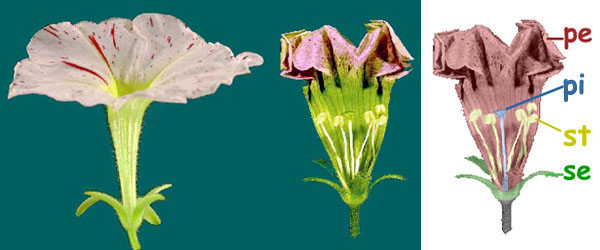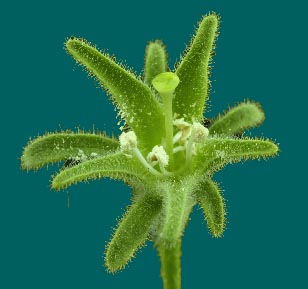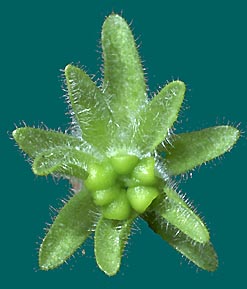How plants make flowers
| To the fesem simulator... |

|
Click on the gray image here left to load the virtual FESEM or
open a new window.
The FESEM simulator works with Java. If the required Java (TM) plug-in 1.3 is not installed yet on your computer, you will be automatically redirected to Sun Microsystems, Inc. Follow the (simple) step-by-step instructions to download the free plug-in. After completion of the installation procedure the virtual FESEM will be launched automatically.
|  |
FESEM images of a flower bud: M. Wolter-Arts and M. Vandenbussche.
Copyright and disclaimer
The floral organs
In this page a particular plant unit, i.e. the flower, will be discussed. First of all, we have to remark that no matter how different flowers might look to you, they are actually all built in the same way. In principle, a flower consists of four concentric whorls with flower organs. Sometimes, one (or more) of these whorls is barely developed; sometimes one whorl is so dominant that the rest of the flower organs is hardly visible. However, at closer view, it appears that in fact these four types of organs are always present.
| Entire and longitudinally cut flower of Petunia (wild type) |
 |
se = sepals
pe = petals
st = stamens
pi = pistil
|
The image shows an entire (wild type) flower of Petunia and an opened flowerbud. The four floral organs are (from the exterior to the interior): the
sepals (se), the
petals (pe), the
stamens (st) and the
pistil (pi). Sepals and petals together form
the perianth (literally: around the flower); the pollen grains, wchich develop in the stamens, bear the male gametes. In the pistil, embryo sacs are formed which contain the egg cells (female gametes).
How are the different floral organs constructed
In flower development a particular order is followed: the sepals and petals are created first, protecting the more interior stamens and pistil. Subsequently, the anthers develop, and latest of all the pistil. When all the gametes have developed, petals, stamens and pistil grow simultaneously to reach their final length. Finally, at flower maturity, the petals have unfolded to allow for example attraction of insects. (
More information on flower development). Flowers make colours and odours to attract specific animals that are important for pollination. Also, there are many plants that disperse their pollen via the wind. These have most often little or poorly developed petals.
When does a plant decide to start making flowers
For making flowers, a plant must first 'feel like it': it must be warm enough (or on the contrary, cold enough), day light must be long enough (or short enough), and the plant must be sufficiently developed. If all prerequisites are met, the plant decides to switch on the program for flower development. A second step is to decide the number and position of flowers and the order according to which different floral organs will be constructed. At this point, the plant calls in a number of genes. First of all, genes are activated that ensure that the whole program is switched on: The Great Regulators (like when building a house, first the Architect, the Building Contractor, the Performer), enabling all structural genes (the Carpenters, the Bricklayers, the Electricians, the Painters) to do their job each at its turn. Besides that, the correct building materials (stones, wood, paint, pipelines) must be delivered in the correct amounts at the right place. When everything goes according to plan, a complete flower develops in a week or two.
Which genes have which function
To examine which genes have which function in the flower, the best option is to selectively break down single parts (mutate). It can be compared to the investigation of how a house is constructed. By cutting the cables one by one, you can check the function for each of them. When you switch off the central heating boiler, you will notice that it is getting colder. In the same way, by making or searching mutations, one can examine which genes are important in the making of a flower (or any other organs). Let's take a closer look at some of these mutants.
| Flower in Petunia mutants |
 |  |
In the mutant left here above, you can see the presence of all four concentric whorls of floral organs. In the second whorl however, sepals are made instead of petals. This is what we call homeotic mutations: the replacement of one organ by another one. By looking for the mutation (which is still a lot of work) and examining which kind of gene has been mutated, we get more insight in the regulation of flower development. Other mutants for example, make a lot of pistils instead of stamens.
A very special mutant is shown here above right: in fact all organs seem to be confused and seem to do whatever they feel like: here a gene is involved that is responsible for the availability of a lot of structural proteins (the Workers) at the right place and time, and in the correct amounts. You can imagine that the whole organisation collapses when this particular gene is disrupted.
That is the way we slowly improve our insight in how plants make flowers. Since our food is derived mainly from flowers and seeds, you can imagine how important
this kind of research is.
Source: Department of
Plant Genetics.
Former head:
Prof Dr AGM Gerats.
Images and text contributions: Dr. AGM Gerats, Ir. SE Royaert, Ir. F. Cnudde, Dr. M. Vandenbussche, H. Geurts and Ir. M. Wolter-Arts.
Contact for this webpage.
Software development: Jeroen van Beurden. Web structure: Remco Aalbers. Webpage: Elisabeth Pierson







